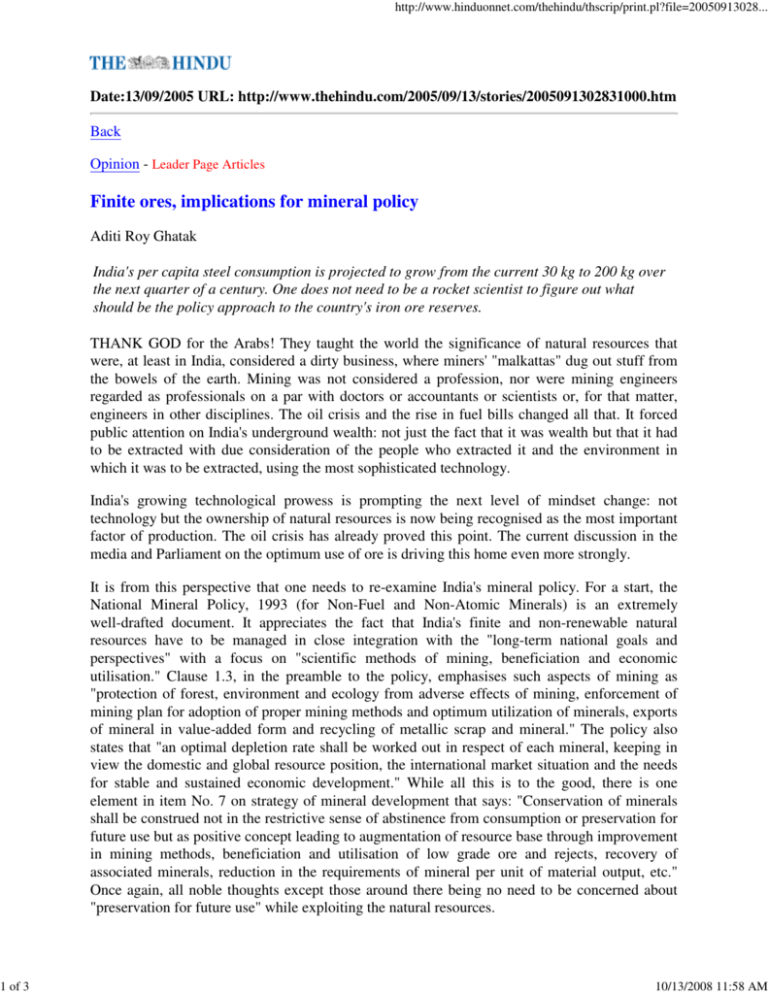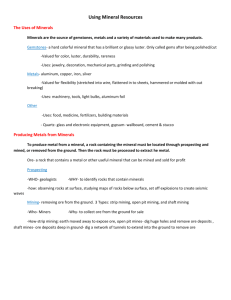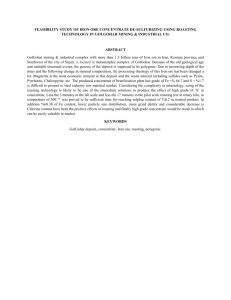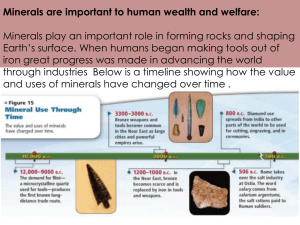Finite ores, implications for mineral policy
advertisement

http://www.hinduonnet.com/thehindu/thscrip/print.pl?file=20050913028... Date:13/09/2005 URL: http://www.thehindu.com/2005/09/13/stories/2005091302831000.htm Back Opinion - Leader Page Articles Finite ores, implications for mineral policy Aditi Roy Ghatak India's per capita steel consumption is projected to grow from the current 30 kg to 200 kg over the next quarter of a century. One does not need to be a rocket scientist to figure out what should be the policy approach to the country's iron ore reserves. THANK GOD for the Arabs! They taught the world the significance of natural resources that were, at least in India, considered a dirty business, where miners' "malkattas" dug out stuff from the bowels of the earth. Mining was not considered a profession, nor were mining engineers regarded as professionals on a par with doctors or accountants or scientists or, for that matter, engineers in other disciplines. The oil crisis and the rise in fuel bills changed all that. It forced public attention on India's underground wealth: not just the fact that it was wealth but that it had to be extracted with due consideration of the people who extracted it and the environment in which it was to be extracted, using the most sophisticated technology. India's growing technological prowess is prompting the next level of mindset change: not technology but the ownership of natural resources is now being recognised as the most important factor of production. The oil crisis has already proved this point. The current discussion in the media and Parliament on the optimum use of ore is driving this home even more strongly. It is from this perspective that one needs to re-examine India's mineral policy. For a start, the National Mineral Policy, 1993 (for Non-Fuel and Non-Atomic Minerals) is an extremely well-drafted document. It appreciates the fact that India's finite and non-renewable natural resources have to be managed in close integration with the "long-term national goals and perspectives" with a focus on "scientific methods of mining, beneficiation and economic utilisation." Clause 1.3, in the preamble to the policy, emphasises such aspects of mining as "protection of forest, environment and ecology from adverse effects of mining, enforcement of mining plan for adoption of proper mining methods and optimum utilization of minerals, exports of mineral in value-added form and recycling of metallic scrap and mineral." The policy also states that "an optimal depletion rate shall be worked out in respect of each mineral, keeping in view the domestic and global resource position, the international market situation and the needs for stable and sustained economic development." While all this is to the good, there is one element in item No. 7 on strategy of mineral development that says: "Conservation of minerals shall be construed not in the restrictive sense of abstinence from consumption or preservation for future use but as positive concept leading to augmentation of resource base through improvement in mining methods, beneficiation and utilisation of low grade ore and rejects, recovery of associated minerals, reduction in the requirements of mineral per unit of material output, etc." Once again, all noble thoughts except those around there being no need to be concerned about "preservation for future use" while exploiting the natural resources. 1 of 3 10/13/2008 11:58 AM http://www.hinduonnet.com/thehindu/thscrip/print.pl?file=20050913028... If one takes a leaf out of the overall approach to natural resources by advanced countries, one realises how zealously the United States, for instance, conserves its mineral reserves, scarcely touching any of its reserves but importing whatever it can to ensure that the country's long-term mineral interests are protected. As for the parliamentary and public debate on India's iron ore reserves and the advisability of exporting the ore to international steel majors, it is interesting to study the global iron ore picture projected by the U.S. Geological Survey MCS 2005: Ukraine has the largest reserves at 68 billion tonnes followed by Brazil (62 billion tonnes), Russia (56 billion tonnes), China (46 billion tonnes), Australia (40 billion tonnes), Kazakhstan (19 billion tonnes), India (18 billion tonnes), the United States (15 billion tonnes), Sweden (8 billion tonnes), Venezuela (6 billion tonnes) and others (32 billion tonnes), adding up to a total global reserve of 370 billion tonnes. Given the current rate of consumption and realistically assuming that 50 per cent of the world steel output will use recycled steel scrap, the global reserves of iron ore are expected to last for 300 to 350 years. Where does India stand in this scenario? It is instructive to take up India and China for comparison in terms of what could be the likely demand for iron ore and what are the factors that should influence the policies of the two countries around iron ore, a critical component for steel-making. China, with its substantially higher reserves of 46 billion tonnes, does not export iron ore. Beijing believes in conserving its own ore because it realises the strategic importance of these reserves from a long-term perspective. One is astonished to learn, therefore, that at the highest levels of policy-making in New Delhi, there is a belief that India has iron ore reserves that will last for 200 years. One suspects that such numbers are arrived at on the assumption that India will remain in its current stage of underdevelopment and that, therefore, steel usage will not increase. The current global consumption of steel is 1,000 million tonnes per annum, which works out to 150 kg per capita. India's per capita consumption is 30 kg in comparison to China's 220 kg which, in turn, compares with the most advanced countries' consumption of between 300 kg and 400 kg. On the basis of current GDP growth projections, India's requirement of steel will grow to 200 kg per capita over the next quarter of a century. One does not need to be a rocket scientist to figure out what the accompanying raw material and other infrastructural requirements to meet such demand for steel would be and, therefore, what should be India's approach to its iron ore reserves. Who are the current iron ore exporters? They include Australia with a population of around 20 million, a domestic consumption of 8 million tonnes of steel, a production of 213 million tonnes of iron ore, and considerable unproven reserves. One does not question the rationale for ore exports from such a country. Nor does one question the rationale of Brazilian ore exports because with its current population of 180 million, steel consumption of 20 million and reserves of 62 billion tonnes, Brazil has enough reserves for hundreds of years. However, there is need to question the rationale of exporting 70 million tonnes of iron ore from India. There are the means to stop such ore exports by introducing technology down to the lowest levels of ore beneficiation, through effective pelletisation, which will ensure use of the last bit of ore and obviate any wastage. The other thing to do is to question the validity of some 30 mt to 40 mt of lump exports through government-owned canalising agencies. Iron ore processing leads to the generation of lumps and ores, by and large in a 60:40 ratio in the Indian context. The more sophisticated steel plants sinter the fines and use them in blast furnaces to the extent possible under current levels of technology. Many sponge iron plants in the country, however, use only lumps and the fines go abegging. Under the current mineral policy, the export of these fines is permitted to prevent them from ending up in waste dumps that unutilisable fines 2 of 3 10/13/2008 11:58 AM http://www.hinduonnet.com/thehindu/thscrip/print.pl?file=20050913028... normally end up in. Some steel companies that use lumps and fines in the proportion of their natural occurrences for their own consumption do export fines when they supply lumps to the sponge iron industry; these fines do not have other buyers in the domestic market. Even this is not an acceptable proposition because it is possible to pelletise such fines to ensure that every bit of iron ore fine is utilised. Steel manufacturers and sponge iron units in the country should be especially enjoined to do so. Meanwhile, any attempt to mine ore for the exclusive purpose of exports, with or without a `swap' clause, should be rejected forthwith for this will be clearly against even current mineral policy, which permits only value-added exports. The `swap' clause is disturbing, to say the least. It is of recent origin and introduced into bureaucratic parlance around ore exports after global majors have come knocking at India's doors. It is all the more disturbing because the Union Minister of Mines used the word `swap' while justifying the ore exports in response to questions at the recent calling attention motion on the subject in Parliament. To come back to the Mineral Policy published in 1993, it will be worthwhile to take all technological developments into account while reconsidering it for India's needs as envisaged in the first decade of the 21st century. There is a need to take a fresh look at the stringency norms around the use of mineral reserves so that plants optimising the use of minerals are incentivised and those wasting resources are made to pay penal charges. Hospitality to global investors must be tempered with self-interest. The reality is that India's mineral wealth and domestic technological capability are major national strengths. In a world where ore owner is king, India has to leverage this clout to secure a position of advantage in every global negotiation around Indian minerals. © Copyright 2000 - 2008 The Hindu 3 of 3 10/13/2008 11:58 AM






